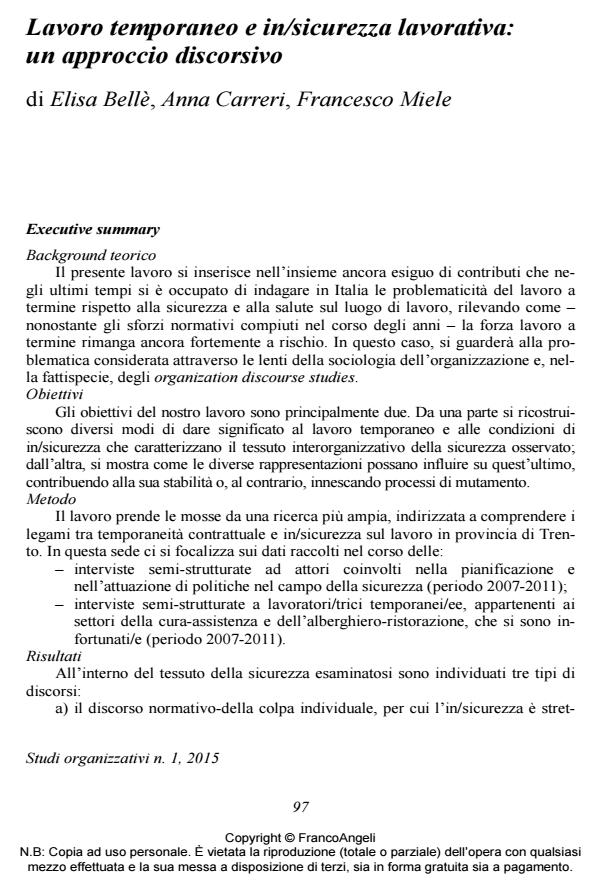Lavoro temporaneo e in/sicurezza lavorativa: un approccio discorsivo
Journal title STUDI ORGANIZZATIVI
Author/s Elisa Bellè, Anna Carreri, Francesco Miele
Publishing Year 2015 Issue 2015/1
Language Italian Pages 27 P. 97-123 File size 233 KB
DOI 10.3280/SO2015-001005
DOI is like a bar code for intellectual property: to have more infomation
click here
Below, you can see the article first page
If you want to buy this article in PDF format, you can do it, following the instructions to buy download credits

FrancoAngeli is member of Publishers International Linking Association, Inc (PILA), a not-for-profit association which run the CrossRef service enabling links to and from online scholarly content.
The article, which fits in the organizational discourse studies, explores how subjects who constitute the interorganizational texture of safety in the province of Trento (policy makers, people who implement policies as well as workers), negotiate what safety and risk in temporary jobs mean within the same discursive context. Drawing from the so called «what’s the problem represented to be approach» (Bacchi, 2009), authors do a discourse analysis of 60 interviews, through which they aim not only to detect different discursive representations of work safety within the specific interorganizational texture of safety analyzed, but also they interrogate the data about what are the discursive, the subjectification, and lived effects produced by those discourses. Three discursive representations of the «problem» of work safety are shown: the discourse focused on the role of laws; that one centered on the organizational and working processes; and the discourse on the quality of (working) life. They not only differ depending on the professional identities and organizational memberships of subjects, but they also produce specific consequences which constrain agency and possibilities for action. Finally, the analysis shows that these discourses, besides having an impact on the organizational and individual levels, produce some recursive effects on the interorganizational texture of safety, which can safeguard it or trigger some changes.
Keywords: Interorganizational texture of safety, temporary jobs, organization discourse studies.
- Understanding the Moderating Effects of Work Status on the Links between Social Exchange, Psychological Contract Fulfilment, and Job Satisfaction Concetta Metallo, Rocco Agrifoglio, Maria Ferrara, in STUDI ORGANIZZATIVI 2/2019 pp.88
DOI: 10.3280/SO2018-002004
Elisa Bellè, Anna Carreri, Francesco Miele, Lavoro temporaneo e in/sicurezza lavorativa: un approccio discorsivo in "STUDI ORGANIZZATIVI " 1/2015, pp 97-123, DOI: 10.3280/SO2015-001005